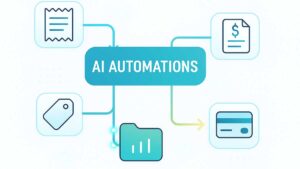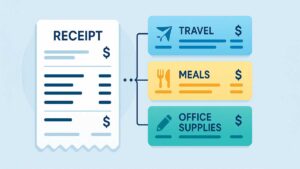The Future of Expense Tracking
Managing expenses is one of the most repetitive – yet critical tasks for individuals, freelancers, and small businesses. Manually sorting receipts into categories takes time, invites errors, and creates headaches at tax season. That’s why automated expense categorization has become one of the most valuable features in modern expense tracking software.
With the rise of AI, categorization has taken a major leap forward. Instead of simply guessing categories based on where you shopped, today’s best tools use AI-driven categorization algorithms to understand what was actually purchased – making reports more accurate, faster to prepare, and less stressful to manage.
In this guide, we’ll break down how expense categorization works, why traditional methods often fail, how AI improves accuracy, and which platforms offer the best automated solutions for 2025.
What Is Automated Expense Categorization?
Automated expense categorization is the process of having your expenses sorted into categories automatically by software. Instead of manually tagging a receipt as “Office Supplies” or “Travel,” the app handles the classification for you.
Modern tools use different approaches:
- Database-based categorization: Matches expenses with a list of known merchants (e.g., Starbucks = Meals).
- Rules-based systems: Categorize based on user-defined conditions (e.g., all Uber charges = Transportation).
- AI-powered categorization: Uses machine learning and natural language processing to analyze line items on the receipt or transaction to determine the right category.
The goal: reduce manual work, improve reporting accuracy, and make financial management easier.
The Problem With Traditional Categorization Methods
Most expense tracking apps rely on merchant-based databases. If you shop at Walmart, it tags the purchase as “Groceries.”
But here’s the problem: Walmart, Target, and Costco sell everything from food to electronics to office supplies. That means:
- Buy printer paper at Walmart → incorrectly tagged as “Groceries.”
- Buy groceries at Walmart → also tagged as “Groceries,” but this time correct.
This oversimplification leads to misclassified transactions and inaccurate reports. Worse:
- If the merchant is not in the database, the system can’t categorize it at all.
- Business owners end up correcting errors manually, wasting the very time automation was meant to save.
How AI Improves Expense Categorization
AI-powered categorization eliminates these issues by focusing on what was purchased, not just where.
Instead of guessing based on merchant names, AI systems like SparkReceipt analyze receipt details or bank transaction descriptions to understand context.
For example:
- Receipt A: Walmart – printer paper, ink cartridges → AI categorizes as Office Supplies.
- Receipt B: Walmart – apples, milk, bread → AI categorizes as Groceries.
With AI categorization, even two receipts from the same store are categorized correctly.
Benefits of AI Categorization
- Accuracy: No more “everything = groceries.”
- Adaptability: Learns from your past edits and supports custom categories.
- Coverage: Handles unknown merchants by reading item details, not relying on a static database.
- Smarter reporting: Expense reports reflect real-world spending patterns.
This is why AI expense categorization is quickly becoming the standard for modern spend management.
Key Benefits of Automated AI Expense Categorization
- Save Time: No more manual tagging of every receipt or transaction.
- Increase Accuracy: Fewer errors in financial reporting, better budgeting, and cleaner books.
- Simplify Tax Preparation: Categories align with tax-deductible expenses, making filing easier.
- Customizable Categories: AI adapts to your personal or business needs.
- Reduce Mental Load: Automating categorization frees up mental energy for more important work.
- Future-Proof: AI algorithms evolve, handling new expense types and transaction formats over time.
What to Look For in AI-Powered Expense Tracking Tools
When evaluating platforms that offer automatic expense categorization, keep an eye out for:
- Receipt scanning with AI categorization
- Bank & credit card transaction imports with automated tagging
- Support for multiple currencies and languages
- Custom categories and rules that AI can learn from
- Integrations with accounting software (QuickBooks, Xero, etc.)
- Export options (Excel, PDF) for reporting and sharing
Best AI Expense Categorization Tools (2025 Update)
If you’re looking for platforms that can automatically categorize expenses with AI, here are some of the best options:
1. SparkReceipt (Best for freelancers, SMBs, and remote teams)
- Uses OpenAI-powered categorization to analyze line items, not just merchants.
- Works in 150+ currencies and any language.
- Offers custom categories and learns from your edits.
- Integrates directly with QuickBooks Online for accounting.
- Exports in Excel or PDF for easy reporting.
Perfect for small business owners, freelancers, consultants, and distributed teams.
2. Expensify
- Popular expense tracker with automated categorization.
- Good for larger teams with reimbursements and approval flows.
3. Zoho Expense
- Affordable option for SMBs.
- Includes AI-powered categorization and automation.
4. QuickBooks Online / Xero
- Accounting platforms with built-in transaction auto-categorization.
- Great for businesses already managing their books in these systems.
Why SparkReceipt Stands Out
Unlike most expense trackers, SparkReceipt doesn’t just categorize based on the merchant. It uses AI to look at the actual items purchased – meaning no more “Walmart = Groceries” errors.
That means:
- Cleaner financial reports
- Less time spent fixing mistakes
- Smarter tax prep with more accurate categories
For freelancers and small businesses, SparkReceipt provides enterprise-grade AI categorization without the complexity or cost of big corporate tools.
Conclusion
Manual expense categorization is time-consuming. Traditional database-driven auto-categorization is inaccurate.
The future of expense tracking is AI-powered categorization – faster, smarter, and more reliable.
With tools like SparkReceipt, you can:
- Scan and categorize receipts automatically
- Ensure expenses are classified correctly
- Save time and reduce stress at tax season
Try SparkReceipt today and see how AI can transform your expense tracking with automatic categorization that actually works.




